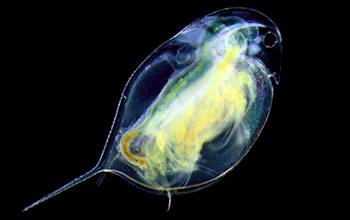Multimedia Gallery
Zooplankton Daphnia pulex (Image 1)
Research shows that a common species of zooplankton, Daphnia pulex, can evolve a tolerance to moderate levels of road salt in as little as two and a half months. [See related image Here.]
More about this image
Researchers at Rensselaer Polytechnic Institute have found a link between distruption in circadian rhythms -- the biological "clock" whose disturbance is linked to chronic inflammation and a host of human disorders -- and plankton that have adapted to road salt pollution.
"This research shows that exposure to environmental toxins may be depressing the function of our circadian clock, the disruption of which is linked to increased rates of cancer, diabetes, obesity, heart disease and depression," says Jennifer Hurley, an assistant professor of biological sciences, a member of the Center for Biotechnology and Interdisciplinary Studies (CBIS) at Rensselaer and senior author of a published paper on the research. "This is the first time anyone has shown this happening at the level of the core clock, which we had considered to be heavily buffered against these types of environmental effects."
The research builds on recent research findings by the Jefferson Project at Lake George. Project research found the common zooplankton species Daphnia pulex can evolve a tolerance to moderate levels of road salt in as little as two and a half months. The researchers produced five populations of Daphnia that adapted to salt concentrations ranging from the current concentration of 15 milligrams-per-liter of chloride in Lake George to concentrations of 1,000 milligrams-per-liter, as found in highly contaminated lakes in North America.
Rick Relyea, the Jefferson Project director and a CBIS member and co-author of the study, says that plankton -- key consumers of algae and a food source for many fish -- may be making a monumental tradeoff to tolerate increased road salt. "The circadian rhythm guides these animals through a daily migration to deep waters during the day to hide from predators and shallow waters at night to feed. Disrupting that rhythm could affect the entire lake ecosystem," says Relyea.
Hurley says adaptation to salt is likely affecting Daphnia at the epigenetic level, a heritable change in gene levels rather than genetic code. The research has wide applicability in multiple fields beyond human health.
The research was funded in part by a National Science Foundation (NSF) Graduate Research Fellowship.
To learn more about this research, see the NSF News From the Field story Can environmental toxins disrupt the biological 'clock?' (Date image taken: 2016; date originally posted to NSF Multimedia Gallery: April 13, 2018)
Credit: Brian Mattes, Rensselaer Polytechnic Institute
See other images like this on your iPhone or iPad download NSF Science Zone on the Apple App Store.
Images and other media in the National Science Foundation Multimedia Gallery are available for use in print and electronic material by NSF employees, members of the media, university staff, teachers and the general public. All media in the gallery are intended for personal, educational and nonprofit/non-commercial use only.
Images credited to the National Science Foundation, a federal agency, are in the public domain. The images were created by employees of the United States Government as part of their official duties or prepared by contractors as "works for hire" for NSF. You may freely use NSF-credited images and, at your discretion, credit NSF with a "Courtesy: National Science Foundation" notation.
Additional information about general usage can be found in Conditions.
Also Available:
Download the high-resolution JPG version of the image. (460.0 KB)
Use your mouse to right-click (Mac users may need to Ctrl-click) the link above and choose the option that will save the file or target to your computer.

